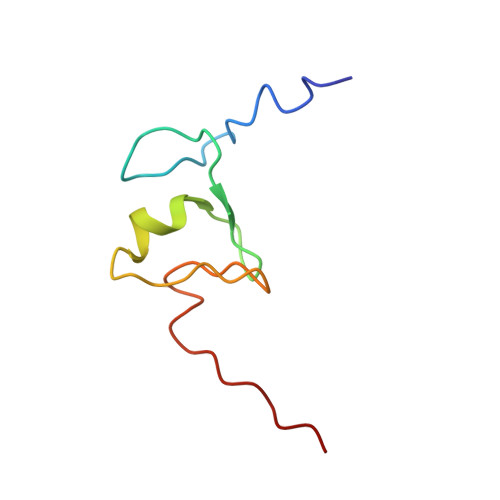AIRE-PHD fingers are structural hubs to maintain the integrity of chromatin-associated interactome.
Gaetani, M., Matafora, V., Saare, M., Spiliotopoulos, D., Mollica, L., Quilici, G., Chignola, F., Mannella, V., Zucchelli, C., Peterson, P., Bachi, A., Musco, G.(2012) Nucleic Acids Res 40: 11756-11768
- PubMed: 23074189
- DOI: https://doi.org/10.1093/nar/gks933
- Primary Citation of Related Structures:
2LRI - PubMed Abstract:
Mutations in autoimmune regulator (AIRE) gene cause autoimmune polyendocrinopathy candidiasis ectodermal dystrophy. AIRE is expressed in thymic medullary epithelial cells, where it promotes the expression of peripheral-tissue antigens to mediate deletional tolerance, thereby preventing self-reactivity. AIRE contains two plant homeodomains (PHDs) which are sites of pathological mutations. AIRE-PHD fingers are important for AIRE transcriptional activity and presumably play a crucial role in the formation of multimeric protein complexes at chromatin level which ultimately control immunological tolerance. As a step forward the understanding of AIRE-PHD fingers in normal and pathological conditions, we investigated their structure and used a proteomic SILAC approach to assess the impact of patient mutations targeting AIRE-PHD fingers. Importantly, both AIRE-PHD fingers are structurally independent and mutually non-interacting domains. In contrast to D297A and V301M on AIRE-PHD1, the C446G mutation on AIRE-PHD2 destroys the structural fold, thus causing aberrant AIRE localization and reduction of AIRE target genes activation. Moreover, mutations targeting AIRE-PHD1 affect the formation of a multimeric protein complex at chromatin level. Overall our results reveal the importance of AIRE-PHD domains in the interaction with chromatin-associated nuclear partners and gene regulation confirming the role of PHD fingers as versatile protein interaction hubs for multiple binding events.
Organizational Affiliation:
Biomolecular NMR Laboratory, Center of Translational Genomics and Bioinformatics, Dulbecco Telethon Institute c/o S. Raffaele Scientific Institute, Milano, Italy.















